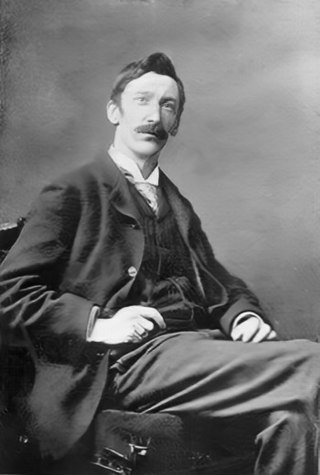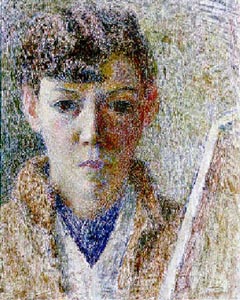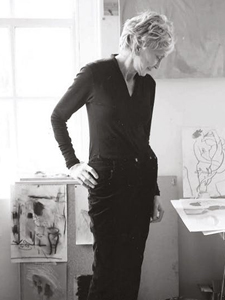Related Research Articles
Sir Terence Ernest Manitou Frost RA was a British abstract artist, who worked in Newlyn, Cornwall. Frost was renowned for his use of the Cornish light, colour and shape to start a new art movement in England. He became a leading exponent of abstract art and a recognised figure of the British art establishment.

Henry Scott Tuke, was an English artist. His most notable work was in the Impressionist style and he is best known for his paintings of nude boys and young men.

Stanhope Alexander Forbes was a British artist and a founding member of the influential Newlyn school of painters. He was often called 'the father of the Newlyn School'.
Walter Bryan Pearce was a British painter. He was recognised as one of the UK's leading naïve artists.

Wilhelmina Barns-Graham CBE was one of the foremost British abstract artists, a member of the influential Penwith Society of Arts.
Trevor Bell was an English Leeds-born artist and contemporary visual artist.
John Clayworth Spencer Wells was an artist and maker of relief constructions, associated with the St Ives group.

Dod Procter, born Doris Margaret Shaw, (1890–1972) was an English artist, and the wife of the artist Ernest Procter. Her painting Morning was bought for the public by the Daily Mail in 1927.
Denis Adeane Mitchell was an English abstract sculptor who worked mainly in bronze and wood. A prominent member of the St Ives group of artists, he worked as an assistant to Barbara Hepworth for many years.

Rose Hilton, née Phipps was a British painter living in Cornwall. Her husband said that he would be the only artist in their relationship, but she achieved recognition after he died.
Alexander Mackenzie was a British abstract artist, an active member of the Penwith Art Society and Newlyn Art Gallery and educator. Mackenzie was born on 9 April 1923 in Liverpool. He was married to Coralie Crockett and the couple had three daughters, Pat, Althea and Rachel.
Annie Walke or Anne Fearon Walke was an English artist. Anne Fearon grew up and was schooled in Banstead, Surrey. After completing her studies at the Chelsea School of Art and the London School of Art, she and her sister, Hilda Fearon, furthered their studies in Dresden, Germany. About the turn of the 20th century Miss Fearon settled in Cornwall, where she continued her studies and established a studio in the Cornish coastal village of Polruan. After she married Nicolo Bernard Walke in 1911, she soon moved with him to St Hilary, Cornwall. where her husband became the vicar in 1913. She was a member of the Newlyn School and other artists' organizations and created portraits and religious works for churches. Her work has been exhibited in England, Paris, America and South Africa. In the latter part of her life Walke was a published poet.
Clifford Fishwick was a painter and Principal of Exeter College of Art and Design who exhibited regularly with the Newlyn and Penwith Societies. Fishwick is regarded as an important if underrated figure in post-war British painting.

Ray Atkins is a British figurative artist, member of the St Ives School & the London Group and educator. He was born in 1937 in Exeter, Devon, and studied art at Bromley College of Art and at the Slade School of Fine Art. He is known particularly for his large paintings, painted in situ over a period of weeks or months.

Albert Julius Olsson was a British maritime artist and keen yachtsman. Olsson cruised with his yacht most summers, and The Studio commented: 'He knows the way from the Scillies to the Isle of Wight as most men know their way to the nearest railway station.'
Barrie Cook was a British abstract artist who lived and worked on The Lizard in Cornwall, England.

Andrew Litten is a Cornwall-based English artist born in 1970 in Aylesbury, UK. His paintings have been exhibited in the United Kingdom, including the Tate Modern in London, China, USA, Germany, Australia, Mexico, Poland and Italy.
Caroline Burland Gotch was a British artist and part of the Newlyn School.

Albert Reuss was an Austrian-born British painter and sculptor. He was born in Vienna and fled to Britain in 1938 following the Anschluss, Adolf Hitler’s annexation of Austria to the German Reich. In the process, Reuss lost many members of his family, and the reputation he had built up as an artist in Vienna. He continued to work as an exiled artist, but his style changed dramatically, reflecting the trauma he had suffered. Many public collections in Britain hold his work, most notably Newlyn Art Gallery in Cornwall, the British Museum and the Victoria and Albert Museum in London, the Österreichische Galerie Belvedere and the Albertina both in Vienna, and the Tel Aviv Museum of Art in Israel.
Beatrice Pauline Hewitt (1873-1956) was a British painter who created many works which consisted of ocean-themed landscapes, coastal scenes, flower subjects, figures, and portraits.
References
- ↑ Whybrow, Marion (1994). St Ives, 1883-1993: Portrait of an Art Colony. Antique Collectors' Club. p. 185. ISBN 9781851491704.
- ↑ "Derek Jenkins biography". wave7gallery.co.uk. 30 September 2017.
- ↑ "Wave 7 Gallery - Paintings". wave7gallery.co.uk. 30 September 2017.
- ↑ "Campden Gallery". www.campdengallery.co.uk. Retrieved 26 August 2017.
- ↑ "Campden Gallery". www.campdengallery.co.uk. Retrieved 26 August 2017.
- ↑ "Derek JENKINS - cornwall artists index". cornwallartists.org. Retrieved 26 August 2017.
- ↑ "The New Craftsman Gallery - St. Ives - Cornwall - Derek Jenkins". www.newcraftsmanstives.com. Retrieved 26 August 2017.
- ↑ Falmouth Art Gallery 20 Years of Contemporary Art at Falmouth Art Gallery 1980-2000.
- ↑ RCM & RIC Three Spires Festival Exhibition of Paintings, Sculpture and Pottery, Truro (Opening of the RCM or County Art Gallery, by the Royal Institution of Cornwall).
- ↑ Hardie (1995) 100 Years in Newlyn: Diary of a Gallery (List of NSA Members at Centennial).